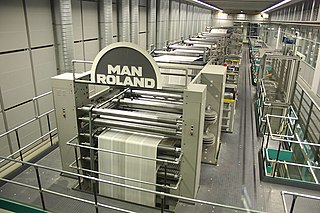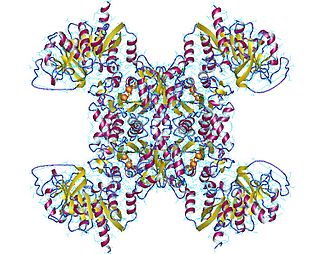
Rubber, also called India rubber, latex, Amazonian rubber, caucho, or caoutchouc, as initially produced, consists of polymers of the organic compound isoprene, with minor impurities of other organic compounds. Thailand, Malaysia, and Indonesia are three of the leading rubber producers.

Uridine-5′-triphosphate (UTP) is a pyrimidine nucleoside triphosphate, consisting of the organic base uracil linked to the 1′ carbon of the ribose sugar, and esterified with tri-phosphoric acid at the 5′ position. Its main role is as substrate for the synthesis of RNA during transcription. UTP is the precursor for the production of CTP via the help of CTP Synthetase. UTP can be biosynthesized from UDP by Nucleoside Diphosphate Kinase after using phosphate group from ATP. UDP + ATP ⇌ UTP + ADP; both UTP and ATP are energetically equal
Prepress is the term used in the printing and publishing industries for the processes and procedures that occur between the creation of a print layout and the final printing. The prepress procedure includes the manufacture of a printing plate, image carrier or form, ready for mounting on a printing press, as well as the adjustment of images and texts or the creation of a high-quality print file. In today's prepress shop, the form of delivery from the customer is usually electronic, either a PDF or application files created from programs such as Scribus, Adobe InDesign, Adobe Illustrator, or QuarkXPress.

Offset printing is a common printing technique in which the inked image is transferred from a plate to a rubber blanket and then to the printing surface. When used in combination with the lithographic process, which is based on the repulsion of oil and water, the offset technique employs a flat (planographic) image carrier. Ink rollers transfer ink to the image areas of the image carrier, while a water roller applies a water-based film to the non-image areas.

Hevea brasiliensis, the Pará rubber tree, sharinga tree, seringueira, or most commonly, rubber tree or rubber plant, is a flowering plant belonging to the spurge family Euphorbiaceae. It is the most economically important member of the genus Hevea because the milky latex extracted from the tree is the primary source of natural rubber.

A monofin is a type of swimfin typically used in underwater sports such as finswimming, free-diving and underwater orienteering. It consists of a single or linked surfaces attached to both of the diver's feet, emulating the fluke of Cetaceans like whales or porpoises.

The Republican Turkish Party is a social-democratic political party in Northern Cyprus. The party was founded in 1970 by Ahmet Mithat Berberoğlu, a lawyer, in opposition to the leadership of Fazıl Küçük and Rauf Denktaş.
Nitrile rubber, also known as nitrile butadiene rubber, NBR, Buna-N, and acrylonitrile butadiene rubber, is a synthetic rubber derived from acrylonitrile (ACN) and butadiene. Trade names include Perbunan, Nipol, Krynac and Europrene. This rubber is unusual in being resistant to oil, fuel, and other chemicals.

Computer-to-plate (CTP) is an imaging technology used in modern printing processes. In this technology, an image created in a Desktop Publishing (DTP) application is output directly to a printing plate.
The MIT Center for Theoretical Physics (CTP) is the hub of theoretical nuclear physics, particle physics, and quantum information research at MIT. It is a subdivision of MIT Laboratory for Nuclear Science and Department of Physics.

Cytidine triphosphate (CTP) is a pyrimidine nucleoside triphosphate. CTP, much like ATP, consists of a ribose sugar, and three phosphate groups. The major difference between the two molecules is the base used, which in CTP is cytosine.
Sandcastle is a documentation generator from Microsoft. It automatically produces MSDN-style code documentation out of reflection information of .NET assemblies and XML documentation comments found in the source code of these assemblies. It can also be used to produce user documentation from Microsoft Assistance Markup Language (MAML) with the same look and feel as reference documentation.
The Association of Technology, Management and Applied Engineering (ATMAE) sets standards for academic program accreditation, personal certification and professional development for educators and industry professionals involved in integrating technology, leadership and design. Its primary mission is faculty, students and industry professionals dedicated to solving complex technological problems and developing the competitive technologist and applied engineering workforce.

CTP synthase is an enzyme involved in pyrimidine biosynthesis that interconverts UTP and CTP.

CTP synthase 2 is an enzyme that in humans is encoded by the CTPS2 gene.
Classical Theatre Project is a professional theatre company based in Toronto, Ontario that creates innovative productions of classic plays for a new generation of theatre fans. The company was founded in 2001 and focuses on producing the works of William Shakespeare. Since its creation, the CTP has played to more than 500,000 audience members across Canada and the U.S.

CTP synthase 1 is an enzyme that is encoded by the CTPS1 gene in humans. CTP synthase 1 is an enzyme in the de novo pyrimidine synthesis pathway that catalyses the conversion of uridine triphosphate (UTP) to cytidine triphosphate (CTP). CTP is a key building block for the production of DNA, RNA and some phospholipids.
.NET Compiler Platform, also known by its codename Roslyn, is a set of open-source compilers and code analysis APIs for C# and Visual Basic (VB.NET) languages from Microsoft.
Diacylglycerol kinase is an enzyme with systematic name CTP:1,2-diacyl-sn-glycerol 3-phosphotransferase. This enzyme catalyses the following chemical reaction











